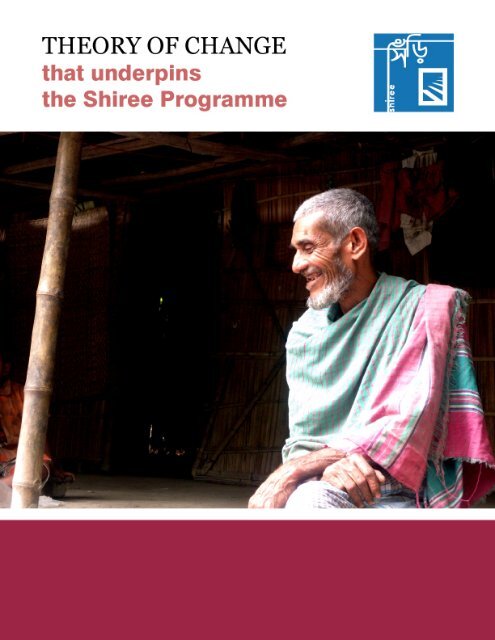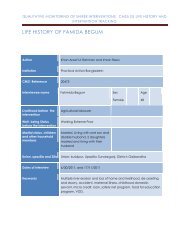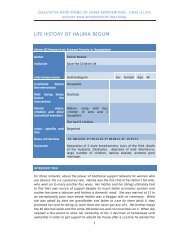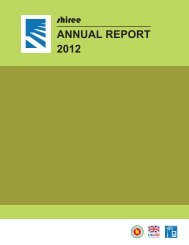Theory of Change - Shiree
Theory of Change - Shiree
Theory of Change - Shiree
Create successful ePaper yourself
Turn your PDF publications into a flip-book with our unique Google optimized e-Paper software.
<strong>Theory</strong> <strong>of</strong> <strong>Change</strong><br />
1. Contextual Analysis<br />
The 2010 Bangladesh Household Income and Expenditure Survey (HIES) reported 17.6% <strong>of</strong> the<br />
population as falling below the lower poverty line. That is over 28 million people. Perhaps three quarters<br />
<strong>of</strong> these are chronically poor in that their poverty is not only severe but also multi-dimensional and long<br />
lasting 1 . These people are not only income poor, but face chronic deficits in the realms <strong>of</strong> food security,<br />
health, nutrition, education, physical security, housing, vulnerability to shocks, social empowerment and<br />
access to rights. This depth and breadth <strong>of</strong> poverty is passed across the generations through economic<br />
(eg lack <strong>of</strong> assets), physical (eg poor nutrition) and social transmission mechanisms, with the latter<br />
including strong gender dimensions and the exclusion <strong>of</strong> marginalised groups.<br />
Extreme poverty is present throughout Bangladesh but is particularly prevalent in 5 regions where the<br />
Economic Empowerment <strong>of</strong> the Poorest Programme (commonly known as the shiree programme,<br />
meaning steps in Bangla) has been active since 2009. These 5 regions are the Chittagong Hill Tractspolitically<br />
and economically marginalised, the NE Haors region- remote with isolated villages flooded for<br />
6 months, the North Western Region – prone to seasonal hunger or “monga” and periodic drought, the<br />
Southern Coastal Belt - extremely vulnerable to climatic shocks including cyclones and tidal surges, plus<br />
Dhaka urban slums and streets.<br />
5 Cases<br />
32 year old man living in Kurigram District. Married with 4<br />
children. Engaged in sporadic day labour.<br />
40 year old married man living in seasonally flooded Haor<br />
region. Adult children. Isolated by floods during rainy season.<br />
Seasonal migration for work.<br />
23 year old physically disabled man, living in Dhaka slum<br />
with wife. Begs for income.<br />
60 year old widow belonging to isolated indigenous<br />
community in remote Chittagong Hill Tracts.<br />
17 year old girl living in climate change affected Satkhira<br />
District. Recently married, working as domestic maid.<br />
Despite being disaster prone, facing severe political disruption and suffering endemically poor<br />
governance and corruption, the Bangladesh economy continues to exhibit strong macro-economic<br />
growth with resultant reductions in aggregate poverty. A key contextual feature is that strong growth<br />
alone will not be sufficient to eradicate extreme poverty given the chronic nature <strong>of</strong> the situation faced<br />
by these and many millions <strong>of</strong> other cases. Purposive programmes targeted at the extreme poor are<br />
needed.<br />
1 See Andrew Shepard, Chronic Poverty Research Centre – Addressing Chronic Poverty 2013
2. A Set <strong>of</strong> Primary Assumptions<br />
First Assumption: Latency to escape from poverty: there are no lost causes!<br />
Despite the severity and multi-dimensional nature <strong>of</strong> their poverty, all extreme poor households have<br />
the latent potential to graduate from extreme poverty.<br />
Evidence: Global History provides evidence over sufficiently long periods <strong>of</strong> time as there are countries<br />
that have successfully defeated or close to defeated extreme poverty in concert with transition to<br />
middle or high income status. What is less clear is whether permanent exit from extreme poverty can be<br />
achieved for the most chronically poor households within the lifetime <strong>of</strong> a, typically 3 year, livelihood<br />
support project operating in a country that has yet to transition to even middle income status. However<br />
there are sufficient case studies <strong>of</strong> dramatic transformation in the lives <strong>of</strong> extremely poor beneficiaries<br />
within prior shiree cohorts to justify adopting the latency assumption.<br />
Second Assumption: There are interventions that are proven to work!<br />
There are well tried and tested interventions that can be implemented at Household Level that<br />
demonstrate a strong likelihood <strong>of</strong> allowing the household to transition out <strong>of</strong> extreme poverty within a<br />
2-3 year period.<br />
Evidence: The shiree programme has targeted the poorest 3-5% <strong>of</strong> the population (ie well below the<br />
lower poverty threshold) in the most difficult to access locations. Implementing NGOs have succeeded in<br />
taking over 60% <strong>of</strong> households out <strong>of</strong> extreme poverty over 3 year intervention periods (<strong>Change</strong><br />
Monitoring System)<br />
5 examples <strong>of</strong> direct interventions<br />
Provided with a cow and artificial insemination technology.<br />
Given nets and secured fishing rights to waterbody.<br />
Provided with skills training and a garments sector job.<br />
Transferred 3 piglets for rearing.<br />
Further Receives support equipment for this assumption and training for is provided crab-fattening. by the success <strong>of</strong> prior programmes such as BRAC-<br />
Further support for this assumption is provided by the success <strong>of</strong> prior programmes such as BRAC-<br />
Challenging the Frontiers <strong>of</strong> Poverty Reduction (CFPR) that reports 90% graduation and the Chars<br />
livelihoods Programme (CLP). The methods adopted by these programmes are broadly similar to shiree<br />
in involving some combination <strong>of</strong> asset and cash transfer plus training and group mobilisation.
Steps out <strong>of</strong> extreme poverty<br />
Graduation Checklist:<br />
Food security<br />
Net cash income<br />
No. <strong>of</strong> Income Sources<br />
Cash Savings<br />
Value <strong>of</strong> Productive<br />
Assets<br />
Non-productive assets<br />
Food diversity<br />
Nutrition<br />
Health<br />
Drinking water<br />
Sanitation<br />
Gender empowerment<br />
Access to land (rural)<br />
Graduated from Extreme Poverty<br />
Skills developed in multiple IGAs,<br />
empowered, food secure, access<br />
to services, savings accumulated.<br />
Community groups formed to<br />
facilitate market linkages, group<br />
savings, support networks and build<br />
confidence and empowerment.<br />
Continued training on IGAs.<br />
Receives asset and training on<br />
asset<br />
Targeted as extremely poor<br />
Third Assumption: The costs <strong>of</strong> complexity can be managed!<br />
It is possible to deliver many thousands <strong>of</strong> livelihood interventions at scale in an efficient manner<br />
without losing the diversity <strong>of</strong> interventions necessary to address locally specific opportunities and<br />
constraints.<br />
Evidence: The shiree programme is already working successfully with 248,000 households in the 5 main<br />
focus regions through about 25 NGO sub contracts. The challenge fund mechanism allows access to a<br />
wide variety <strong>of</strong> region or client group specific NGO working experience and expertise. Client specialisms<br />
amongst current contractors include Help Age, ADD and Handicap (disability), Plan-International (street<br />
children) and DSK (Slum dwellers). Other major contractors have regional presence and established<br />
networks dating back many years, for example – Oxfam and Uttaran in the Southern belt or Caritas and<br />
Greenhill in the Hill Tracts. The Management Agency/Sub-contractor Model enables the diversity in the<br />
portfolio necessary to address the multiple specific determinants <strong>of</strong> poverty while providing a common<br />
monitoring and financial management function and, critically, mechanisms and spaces for knowledge<br />
exchange and shared learning. The result <strong>of</strong> the latter processes is to allow continuous review and<br />
enhancement <strong>of</strong> interventions.<br />
Fourth Assumption: Sustainability - Self-sustaining Momentum towards permanent graduation can be<br />
established.<br />
The sustainability assumption is the most difficult to demonstrate given the impossibility <strong>of</strong> measuring<br />
the post project impact within the lifespan <strong>of</strong> the project itself. The best that can be achieved is to<br />
demonstrate that a positive upward trend is established amongst participating households with<br />
behaviour that supports the conclusion that resilience to subsequent re-impoverishment is being
gradually established. Positive indicators include re-investment in productive asset accumulation,<br />
diversification <strong>of</strong> income sources (a strong indicator <strong>of</strong> resilience), investment in health and education<br />
outcomes for the entire family, accumulation <strong>of</strong> savings, the re-combination <strong>of</strong> families that had become<br />
fragmented through severe traumatic poverty and the increased engagement <strong>of</strong> families with local elites<br />
including government <strong>of</strong>ficials and politicians. There is evidence from programme monitoring systems to<br />
verify all <strong>of</strong> these positive indicators and there is evidence from longer running programmes <strong>of</strong> a similar<br />
nature, such as those <strong>of</strong> BRAC, that livelihood gains continue on an upward trend. Nevertheless it is<br />
indisputable that families remain highly vulnerable to shocks felt either at the level <strong>of</strong> the household,<br />
the community or even the nation (eg a national flood <strong>of</strong> 1998 proportions, major cyclone or<br />
earthquake). Systemic social protection reform and/or the advent <strong>of</strong> affordable and effective social<br />
insurance are key medium to long term conditions for protecting the gains from livelihood interventions<br />
and achieving the ultimateeradication <strong>of</strong> extreme poverty. These systemic changes are not entirely<br />
exogenous to the intervention given the inclusion <strong>of</strong> a strong advocacy stream (see below).<br />
Fifth Assumption: “the boundaries <strong>of</strong> permissible thought 2 “can be expanded to encompass the<br />
eradication <strong>of</strong> extreme poverty in Bangladesh<br />
This is the key assumption underlying the research and advocacy work that is core to the programme<br />
model. For research to demonstrate that extreme and chronic poverty can be effectively treated and<br />
how it can be treated. For advocacy to use multiple sources <strong>of</strong> programme and research evidence to<br />
convince those with access to power and resources to take on the idea and to act on the objective <strong>of</strong><br />
achieving zero percent extreme poverty. Without an acceptance <strong>of</strong> this idea as a realistic, doable,<br />
“SMART” objective the perception <strong>of</strong> the extreme poor will continue to be as being worthy <strong>of</strong> charity<br />
but largely excluded,through some combination <strong>of</strong> location, gender, caste, race, age, ability and<br />
education, from the benefits <strong>of</strong> national economic success.<br />
Current programme experience working with the extreme poor has identified the following 6 challenge<br />
areas:<br />
<br />
<br />
<br />
<br />
<br />
<br />
Access to employment opportunities<br />
Vulnerability to external shocks<br />
Gender inequity<br />
Health and Nutrition Vulnerability<br />
Access to Public services and transfers<br />
Marginalised group specific risks and vulnerabilities<br />
The value <strong>of</strong> the research and advocacy activities already underway but scheduled for further support<br />
through the resource bid is that a realistic national programme to address all <strong>of</strong> these areas with the<br />
ultimate objective <strong>of</strong> the eradication <strong>of</strong> extreme poverty is adopted by the political, economic and<br />
intellectual elite <strong>of</strong> the country - across deep political divides. If the combined elite can accommodate,<br />
breed and be motivated to action by this thought it will be possible to eradicate extreme poverty in<br />
2 Shephard - CPRC
Bangladesh- perhaps even by 2021- the 50 th anniversary <strong>of</strong> the formation <strong>of</strong> the country. This would<br />
require taking about 1 million households out <strong>of</strong> extreme poverty each year.<br />
Donors, multilaterals, INGOs and other external actors will play a key facilitating role through their<br />
funding, advocacy and implementation functions.<br />
To summarize:<br />
Assumption Verified Evidence<br />
Sufficient extreme poor<br />
beneficiary households can be<br />
found<br />
√ Programme has successfully recruited 248,000HH in 5<br />
regions. BBS statistics indicate many millions <strong>of</strong><br />
unserved extreme poor despite other programmes<br />
These people have the<br />
potential to emerge from<br />
extreme poverty<br />
A range <strong>of</strong> appropriate<br />
interventions exists<br />
A robust management<br />
mechanism can deliver<br />
appropriate interventions at<br />
scale despite complexity<br />
The continued progression <strong>of</strong><br />
households towards a position<br />
<strong>of</strong> resilience can be supported<br />
√<br />
√<br />
√<br />
√<br />
with a similar target group.<br />
Several large programmes have demonstrated good<br />
success rates with NGO implemented livelihood<br />
support interventions based on asset/cash transfer<br />
with associated training and support.<br />
Implementation experience has led to improved<br />
targeting and design <strong>of</strong> the right intervention based<br />
on analysis <strong>of</strong> individual household need and capacity.<br />
It is no longer “one size fits all” and household level<br />
monitoring using mobile technology provides a rapid<br />
learning loop about what works best.<br />
The challenge fund/Management Agency model<br />
provides this mechanism and value is added through<br />
the inclusion <strong>of</strong> critical learning, sharing and project<br />
enhancement forums and tools based on a dynamic<br />
stream <strong>of</strong> monitoring and research evidence<br />
Within the programme timeframe through continued<br />
monitoring, top up support and contingency<br />
resources. Beyond the programme timeframe through<br />
work with government and other counterparts to<br />
establish a strong national vision and shared<br />
commitment to the eradication <strong>of</strong> extreme poverty –<br />
that will result in systemic reform to social protection<br />
mechanisms and targeting <strong>of</strong> core public services.
thousands more people enabled to graduate from<br />
extreme poverty<br />
(Source: HIES 2010)<br />
Management<br />
Agency and<br />
established<br />
NGO<br />
partnerships<br />
<strong>Change</strong><br />
Monitoring<br />
System<br />
DFID<br />
funds<br />
Effective<br />
implementation<br />
<strong>of</strong> evidence based<br />
interventions<br />
Effective national<br />
and local level<br />
advocacy and<br />
research<br />
Each extreme poor household faces a<br />
unique geographical, economic,<br />
politicalandsocialcontext<br />
But each has the potential to move out<br />
from a life in extreme poverty<br />
32 year old man living in Kurigram District. Married with 4<br />
children. Engaged in sporadic day labour.<br />
Effective project<br />
mgmt. and<br />
financial<br />
oversight<br />
Comprehensive<br />
HH level<br />
information<br />
funding<br />
There are a set <strong>of</strong><br />
conditions necessary for<br />
these interventions to<br />
succeed at scale<br />
Proven<br />
approaches to<br />
poverty reduction<br />
Wider enabling<br />
environmentaccess<br />
to public<br />
services<br />
5 examples <strong>of</strong> locally<br />
appropriate livelihood<br />
interventions<br />
Provided with a cow and<br />
artificial insemination<br />
technology.<br />
5 Cases<br />
40 year old married man living in seasonally flooded Haor<br />
region. Adult children. Isolated by floods during rainy<br />
season. Seasonal migration for work.<br />
23 year old physically disabled man, living in Dhaka slum<br />
with wife. Begs for income.<br />
60 year old widow belonging to isolated indigenous<br />
community in remote Chittagong Hill Tracts.<br />
17 year old girl living in climate change affected Satkhira<br />
District. Recently married, working as domestic maid.<br />
There are well proven<br />
interventions that can<br />
transform the lives <strong>of</strong><br />
these extreme poor<br />
households.<br />
(Prior experience <strong>of</strong> EEP/shiree,<br />
BRAC, CLP and others)<br />
Given nets and secured<br />
fishing rights to<br />
waterbody.<br />
Provided with skills<br />
training and garments<br />
sector job.<br />
Transferred 3 piglets for<br />
rearing.<br />
Receives equipment and<br />
training for crab-fattening.
Political indifference and inaction:<br />
Increased support for national and local<br />
level advocacy initiatives and knowledge<br />
dissemination (i.e. The Manifesto for the<br />
Extreme Poor).<br />
The objective is to<br />
nurture thousands<br />
External shocks: Availability <strong>of</strong> contingency<br />
fund to enable robust response to floods,<br />
fires, evictions etc.<br />
Failure rate: Availability <strong>of</strong> top-up funds<br />
and household targeting mechanism<br />
based on near real time data. Continued<br />
research into the dynamics <strong>of</strong> extreme<br />
poverty leading to the enhancement <strong>of</strong><br />
design interventions.<br />
more household<br />
level economic<br />
empowerment<br />
interventions and to<br />
increase the rate <strong>of</strong><br />
graduation amongst<br />
240,000 prior<br />
beneficiaries<br />
Targeted as extremely poor<br />
Graduated from Extreme Poverty<br />
Skills developed in multiple IGAs, empowered, food<br />
secure, access to services, savings accumulated.<br />
Community groups formed to facilitate market<br />
linkages, group savings, support networks and build<br />
confidence and empowerment. Continued training<br />
on IGAs.<br />
Receives asset and training on asset<br />
Transformation Process out <strong>of</strong> Extreme Poverty<br />
Graduation Checklist:<br />
Food security<br />
Net cash income<br />
No. <strong>of</strong> Income<br />
Sources<br />
Cash Savings<br />
Value <strong>of</strong> Productive<br />
Assets<br />
Non-productive<br />
assets<br />
Food diversity<br />
Nutrition<br />
Health<br />
Drinking water<br />
Sanitation<br />
Gender<br />
empowerment<br />
Access to land<br />
(rural)









